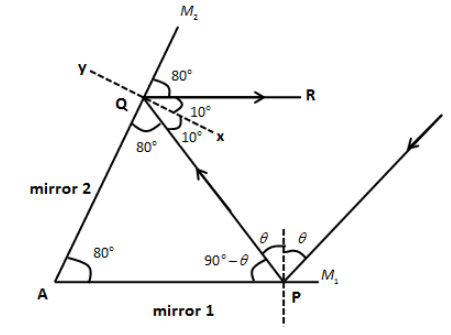
Two plane mirrors are inclined at angle 80 degrees. A ray of light is incident on one of the mirrors. The ray after two reflections will undergo total deviation of:
A. 180 degrees
B. 160 degrees
C. 200 degrees
D. 240 degrees
Answer
452.1k+ views
Hint: We will use the concept of law of reflection which states that when light is reflected from a surface then the angle of incidence is always equal to the angle of reflection angle is measured from the path of the light to the normal to the surface to point at which light strike this is known as law of reflection. The total internal angle of the triangle is equal to $180^\circ $.
Complete step by step answer:
Let ${M_1}$and ${M_2}$ be the mirror inclined at an angle $\theta $with the plane AM.Now a ray of light PQ is incident at an angle $\theta $ on the plane mirror M. We know Snell’s law states that when a light is incident on a plane mirror at an angle $\theta $ then the light will be reflected by making an angle $\theta $.Hence, we can say QR the reflected ray will also make an angle $\theta $ as shown in the following figure.Now let’s draw a line XY normal to the mirror AB, therefore we can say $\angle PQX = \angle RQX$

From the above figure, since the angle \[\angle RQ{M_2}\] is $80^\circ $, then the angle \[\angle RQx = 90 - 80 = 10^\circ \]. Since the angle \[\angle RQx = 10^\circ \], the angle \[\angle PQx\] is also \[10^\circ \]. Therefore, the angle \[\angle AQP = 90 - 10 = 80^\circ \].
As we well know the total internal angle of a triangle is equal to $180^\circ $. Therefore, the total angle in\[\Delta AQP\] is,
$80^\circ + 80^\circ + 90^\circ - \theta = 180^\circ $
By simplifying, we get,
$\theta = 70^\circ $
From the above figure, the total deviation of the light ray is,
\[\delta = 2\theta + 10^\circ + 10^\circ \]
Substituting $\theta = 70^\circ $ in the above equation, we get,
\[\delta = 2\left( {70^\circ } \right) + 10^\circ + 10^\circ \]
\[ \therefore \delta = 160^\circ \]
So, the correct answer is option B.
Note: Students must be careful while using the angles of incidence and the reflected as we have to always take only similar angles that are either made with the horizontal or the vertical. Always remember the angle of reflection or angle of incident are the angles made by the reflected ray or incident ray with the normal and not with the horizontal surface. Do remember the laws of reflection while answering these types of questions.
Complete step by step answer:
Let ${M_1}$and ${M_2}$ be the mirror inclined at an angle $\theta $with the plane AM.Now a ray of light PQ is incident at an angle $\theta $ on the plane mirror M. We know Snell’s law states that when a light is incident on a plane mirror at an angle $\theta $ then the light will be reflected by making an angle $\theta $.Hence, we can say QR the reflected ray will also make an angle $\theta $ as shown in the following figure.Now let’s draw a line XY normal to the mirror AB, therefore we can say $\angle PQX = \angle RQX$

From the above figure, since the angle \[\angle RQ{M_2}\] is $80^\circ $, then the angle \[\angle RQx = 90 - 80 = 10^\circ \]. Since the angle \[\angle RQx = 10^\circ \], the angle \[\angle PQx\] is also \[10^\circ \]. Therefore, the angle \[\angle AQP = 90 - 10 = 80^\circ \].
As we well know the total internal angle of a triangle is equal to $180^\circ $. Therefore, the total angle in\[\Delta AQP\] is,
$80^\circ + 80^\circ + 90^\circ - \theta = 180^\circ $
By simplifying, we get,
$\theta = 70^\circ $
From the above figure, the total deviation of the light ray is,
\[\delta = 2\theta + 10^\circ + 10^\circ \]
Substituting $\theta = 70^\circ $ in the above equation, we get,
\[\delta = 2\left( {70^\circ } \right) + 10^\circ + 10^\circ \]
\[ \therefore \delta = 160^\circ \]
So, the correct answer is option B.
Note: Students must be careful while using the angles of incidence and the reflected as we have to always take only similar angles that are either made with the horizontal or the vertical. Always remember the angle of reflection or angle of incident are the angles made by the reflected ray or incident ray with the normal and not with the horizontal surface. Do remember the laws of reflection while answering these types of questions.
Recently Updated Pages
Master Class 12 Economics: Engaging Questions & Answers for Success

Master Class 12 Maths: Engaging Questions & Answers for Success

Master Class 12 Biology: Engaging Questions & Answers for Success

Master Class 12 Physics: Engaging Questions & Answers for Success

Master Class 12 Business Studies: Engaging Questions & Answers for Success

Master Class 12 English: Engaging Questions & Answers for Success

Trending doubts
Which are the Top 10 Largest Countries of the World?

Differentiate between homogeneous and heterogeneous class 12 chemistry CBSE

Draw a labelled sketch of the human eye class 12 physics CBSE

What is a transformer Explain the principle construction class 12 physics CBSE

What are the major means of transport Explain each class 12 social science CBSE

What is the Full Form of PVC, PET, HDPE, LDPE, PP and PS ?




